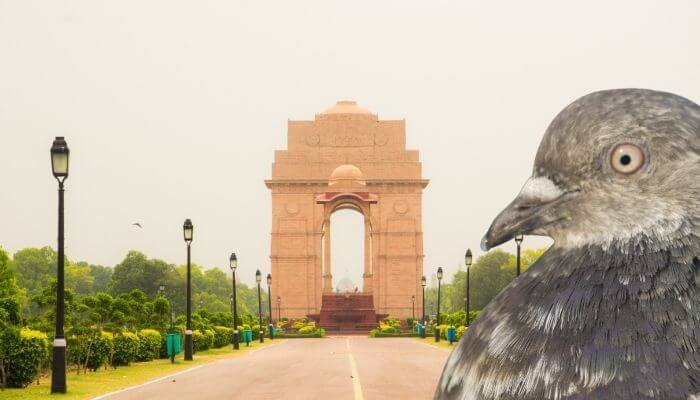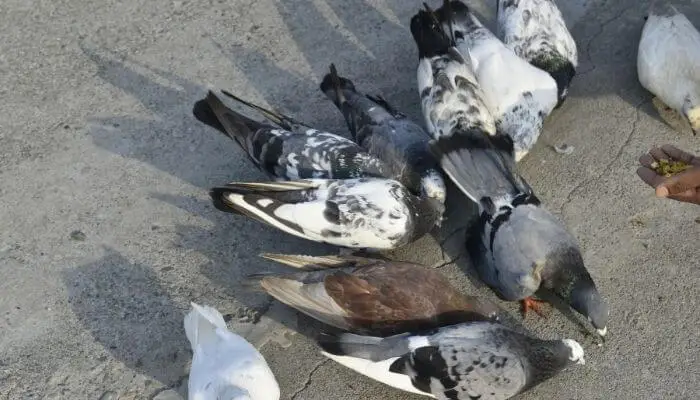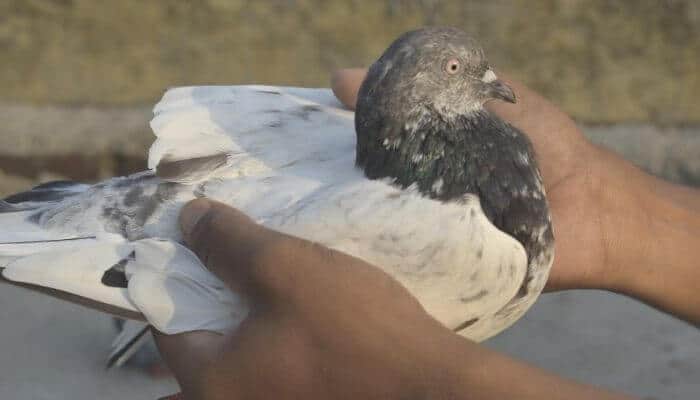The Indian Gola is a type of small domestic breed of homing pigeon known for its strength, endurance and flying ability.
If you think that you might have seen something like the Indian Gola pigeon before, then it might be because they are notoriously similarly looking to the dragoon pigeon.

When it comes to characteristics, however, the Indian Gola pigeon is definitely a breed all of its own.
Origins of the Indian Gola Pigeon
As the name suggests, the Indian Gola pigeon was developed in India and still remains an incredibly popular bird in the sub-continent.
There is very little information about the Indian Gola pigeon breed from before the year 1900. One of the earliest references of the bird was in 1590.
It was noted and included in tales and depictions by Abdul Fazl, who was at that time was the grand vizier of the Mughal emperor Akbar.
It is said that the Emperor adored pigeons and had 20,000 of them.
The Indian Gola pigeon is thought to have descended from a wild field pigeon that was of great taming disposition, being easily domesticated by field workers and farmers in parts of central and northern India.
The Indian Gola pigeon became a very valuable and important part of the economics of farmsteads, actually “employed” by farmers in the harvesting process.
Passionate pigeon racer and fancier, Carl Schoelkopf wrote that during the day, pigeons would pick up spilled grain and when they returned to their roosts in the evening, the field hands would give them heavily salted water to drink.

This would cause regurgitation of the undigested seeds which were then collected, washed and sun-dried to be used.
The gola was introduced to Britain in the early 1900s when an Englishman – J H W Morgan – took some home with him after completing his tenure in the British India Service. He knew these birds are prolific breeders and also because they are a meaty bird despite their size, he introduced them to the squabbing industry.
Squab meat was still a major concern at the turn of the 20th century and a favourite dish around the world was squab pie – also known as pigeon pie depending on the region (for example, in the Middle East/North Africa – pithivier or pastilla is more common.)
The gola never really took off in the USA (pardon the pun!) They were imported into New York by Mr. W Edison Kain (he purchased them from the aforementioned Mr. Morgan) who intended to crossbreed the gola to further improve their squabbing potential.
He tried various breeds including French Gros Mondaines, Maltese pigeons and giant runts.
Kain’s cross-breeding program finished when he produced the Indian Mondaine, a large prolific chicken with squabs that weighed approximately one pound.
The gola had served its purpose and the Indian Mondaine went out of fashion in the USA with the decline in interest in pigeon meat.

Carl Schoelkopf also wrote that as of the year 2009, less than 40 of the Indian Mondaine were kept in the Western World.
Over the centuries, the gola has been mixed and cross-bred with many different wild and domesticated pigeons but the main result is that the ‘accepted” gola pigeon of today is known for its main coloring characteristics of grizzle and tiger patterns.
The genes that produce this color pattern are very dominant and gola pigeons are crossbred with other breeds to specifically generate and replicate this pattern.
Distribution And Habitat of the Indian Gola Pigeon
The Indian gola pigeon is found in large numbers in its native areas of central and northern India.
They are particularly noted around the Taj Mahal which is fitting as Agra was the capital of the Mughal Empire.
The breed is less common, however, in pretty much every other part of the world.
The Indian Gola pigeon is a bird that thrives in a farmstead setting, so in terms of preferred habitat, the open spaces of a farm along with suitable roosting sheds for evening rest make for the ideal environment for this breed.
On YouTube you can find plenty of examples of videos of gola pigeons living in cities in India so this bird is equally adept in both rural and urban environments.
Indian Gola Pigeon Appearance
The Indian Gola pigeon is a small-sized pigeon with distinctive red eyes.
The average body weight of a mature Indian Gola pigeon is around 400 grams (up to 1lb)
| Wingspan | Length | Weight | Coloring | |
| Indian Gola Pigeon | 60-68cm | 25-34cm | 400g | Highly varied, grizzle and tiger patterns. |
| Average Feral Pigeon | 64-72 cm | 32-37cm | 300-500g | Bluish gray with some black. |

The most classic form of the Indian Gola pigeon boasts a pure white body and wings, with a mottled white and darker grey plumage going from the base of the neck to the top of the head.
This is the grizzle and tiger pattern mentioned earlier and these patterns can be in numerous colors.
The bird’s feet are a bright red color to match its eyes.
Character of the Indian Gola Pigeon
Indian Gola pigeons are known for being particularly strong, which is why they make for such excellent flyers thanks to their increased capacity for speed and endurance.
On average, Indian Gola pigeons can reach a top speed of between 65 and 70 mph and can fly for an incredibly impressive 10 to 11 hours straight!
Their great homing instincts indicate a very focused intelligence however, in contrast to this, they are extremely difficult to train for racing and certainly not as adults.
For a gola to be a successful racer, they need to be hand-reared and fed from 10-12 days of age.
Diet of the Indian Gola Pigeon
This breed’s diet is the exemplar of what a pigeon eats.
It is typically a granivorous bird and in rural areas will eat seeds, grains, berries and vegetation. In an urban environment, it will scavenge like any wild town and city pigeon, existing mostly on discarded human food as well as regular foods it finds in gardens.
Mating And Breeding Indian Gola Pigeons
Being largely domestic birds, the process of mating and breeding is very much controlled and dictated by the owners.
Indian Gola pigeons are selected to breed based on impressive traits that the breeder wants to continue such as perfect size, good speed, good flying endurance etc, along with choices about the colors and patterns that they want to achieve.
Taking Care Of Indian Gola Pigeons
With impressive flying being the Indian Gola pigeon’s specialty, you want to make sure that they are provided with sufficient space in their home environment to be able to move around a lot.
They will, of course, also need to be provided with lots of access to the outdoors in order to fine-tune their flying skills and make themselves better and more durable flyers.
Although not good racers, they will usually find their way back to their roosts easily because of their homing instincts.
Generally, Indian Golas are nice-looking birds that make good pets.
